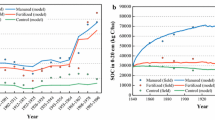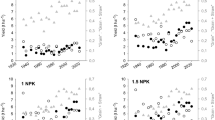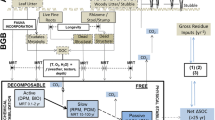Abstract
Soil degradation in the savannah-derived agroecosystems of West Africa is often associated with rapid depletion of organic carbon stocks in soils of coarse texture. Field experiments were conducted over a period of more than 30 years at two sites in semiarid Togo to test the impact of agricultural management practices on soil C stocks and crop productivity. The resulting datasets were analysed using dynamic simulation models of varying complexity, to study the impact of crop rotation, fertiliser use and crop residue management on soil C dynamics. The models were then used to calculate the size of the annual C inputs necessary to restore C stocks to thresholds that would allow positive crop responses to fertilisers under continuous cultivation. Yields of all crops declined over the 30 years irrespective of crop rotation, fertiliser use or crop residue management. Both seed-cotton and cereal grain yields with fertiliser fluctuated around 1 t ha−1 after 20 years. Rotations that included early maturing sorghum varieties provided larger C inputs to the soil through residue biomass; around 2.5 t C ha−1 year−1. Soil C stocks, originally of 15 t ha−1 after woodland clearance, decreased by around 3 t ha−1 at both sites and for virtually all treatments, reaching lower equilibrium levels after 5–10 years of cultivation. Soil C dynamics were well described with a two-pool SOM model running on an annual time step, with parameter values of 0.25 for the fraction of resistant plant material (K1), 0.15–0.20 for the decomposition rate of labile soil C (K2) and 8–10 t C ha−1 for the fraction of stable C in the soil. Simulated addition of organic matter to the soil 30 years after woodland clearance indicated that additions of 3 t C ha−1 year−1 for 15–20 years would be necessary to build ‘threshold’ soil C stocks of around 13 t ha−1, compatible with positive crop response to fertiliser. The simulated soil C increases of 0.5 to 1.6% per year are comparable with results from long-term experiments in the region. However, the amounts of organic matter necessary to build these soil C stocks are not readily available to resource-poor farmers. These experimental results question the assumption that crop residue removal and lack of fertiliser input are responsible for soil C decline in these soils. Even when residues were incorporated and fertilisers used at high rates, crop C inputs were insufficient to compensate for C losses from these sandy soils under continuous cultivation.




Similar content being viewed by others
References
Alvey S, Bagayoko M, Neumann G, Buerkert A (2001) Cereal/legume rotations affect chemical properties and biological activities in two West African soils. Plant Soil 92:45–54
Andrén O, Kätterer T, Karlsson T (2004) ICBM regional model for estimations of dynamics of agricultural soil carbon pools. Nutr Cycl Agroecosyst 70:231–239
Andriulo A, Mary B, Guerif J (1999) Modeling soil carbon dynamics with cropping sequences on the rolling pampas. Agronomie 19:365–377
Arrouays D, Balesdent J, Mariotti A, Girardin C (1995) Modeling organic carbon turnover in cleared temperate forest soils converted to maize cropping by using 13C natural abundance measurements. Plant Soil 173:191–196
Balesdent J, Balabane M (1992) Maize root-derived soil organic carbon estimated by 13C abundance. Soil Biol Biochem 24:97–101
Bationo A, Kihara J, Vanlauwe B, Waswa B, Kimetu J (2006) Soil organic carbon dynamics, functions and management in West African agro-ecosystems. Agric Syst 97:13–25
Berntsen J, Petersen BM, Olesen JE (2006) Simulating trends in crop yield and soil carbon in a long-term experimental—effects of rising CO2, N deposition and improved cultivation. Plant Soil 287:235–245
Bezdicek DF, Papendick RI, Lal R (1996) Importance of soil quality to health and sustainable land management. In: Doran JW, Jones AJ (eds) Methods of assessing soil quality. Soil Science Society of America 49, pp 1–18
Bostick MW, Bado VB, Bationo A, Soler CT, Hoogenboom G, Jones JW (2007) Soil carbon dynamics and residue yields of cropping systems in the Northern Guinea Savannah of Burkina Faso. Soil Till Res 93:138–151
Craufurd PQ, Prasad PVV, Summerfield RJ (2002) Dry matter production and rate of change of harvest index t high temperature in peanut. Crop Sci 42:146–151
Diels K, Valauwe B, Van Der Meerrsch MK, Sanginga N, Merchx R (2004) Long-term soil organic carbon dynamics in a subhumid tropical climate: 13C data in mixed C3/C4 cropping and modeling with RothC. Soil Biol Biochem 36:1739–1750
Falloon P, Smith P, Coleman K, Marshall S (1998) Estimating the size of the inert organic matter pool from total soil organic carbon content for use the Rothamsted carbon model. Soil Biol Biochem 30:1207–1211
Giller KE, Cadisch G, Palm CA (2002) The North-South divide! Organic wastes, or resources for nutrient management. Agronomie 22:703–709
Gottschalk P, Bellarby J, Chenu C, Foereid B, Smith P, Wattenbach M, Zingore S, Smith J (2010) Simulation of soil organic carbon response at forest cultivation sequences using 13C measurements. Organic Geochemistry 41:41–54
Gregory PJ, Reddy MS (1982) Root-growth in an intercrop of pearl-Millet groundnut. Field Crop Res 5:241–252
Hansen S, Jensen HE, Nielsen NE, Sevendsen H (1991) Simulation of nitrogen dynamics and biomass production in winter wheat using the Danisch simulation DAISY. Fert Res 27:245–259
Hénin S, Dupuis M (1945) Essai de bilan de la matière organique des sols. Ann Agron 15:161–172
Holland GA, Coleman DC (1987) Litter placement effects on microbial and organic matter dynamics in an agroecosystem. Ecology 62:425–433
Jenkinson DS, Rayner JH (1977) The turnover of soil organic matter in some of the Rothamsted classical experiments. Soil Sci 123:298–305
Jenkinson DS, Hart PBS, Rayner JH, Parry LC (1987) Modeling the turnover of organic matter in long-term experiments. INTECOL Bull 15:1–8
Keulen HV (2001) Soil organic matter modeling: problems and prospects. In: Christopher & Martius (ed) Managing organic matter in tropical soils, pp 33–37
Kortleven J (1963) Quantitative aspects of humus accumulation and decomposition. Verslagen Landbouwkundige Onderzoekingen 69, Pudoc, Wageningen
Mary B, Guérif J (1994) Intérêts et limites des modèles de prévision de l’évolution des matières organiques et de l’azote dans le sol. Cahiers Agric 3:247–257
Nicolardot B, Molina JAE, Allard MR (1994) C and N fluxes between pools of soil organic matter: model calibration with long-term incubation data. Soil Biol Biochem 26:235–243
Parton WJ, Schimel DS, Cole CV, Ojima DS (1987) Analysis of factors controlling soil organic matter levels in Great Plains grasslands. Soil Sci Soc Am J 51:1173–1179
Pichot J, Sedogo MP, Poulin JF (1981) Evolution de la fertilité d’un sol ferrugineux sous l’influence des fumures minérales et organiques. Agronomie Tropicale 36:122–133
Pieri C (1989) Fertilité des terres des savanes. Ministère de la Coopération CIRAD, 444 p
Plenet D, Lubet E, Juste C (1993) Evolution à long terme du statut carboné du sol en monoculture non irriguée de maïs. Agronomie 13:685–698
Qian JA, Doran JW, Walters DT (1997) Maize plant contributions to root zone available carbon and microbial transformations of nitrogen. Soil Biol Biochem 29:1451–1462
de Ridder N, Breman H, van Keulen H, Stomph TJ (2004) Revisiting a ‘cure against land hunger’: soil fertility management and farming systems dynamics in the West African Sahel. Agric Syst 80:109–131
Roose E, Barthès B (2001) Organic matter management for soil conservation and productivity restoration in Africa: a contribution from Francophone research. Nutr Cycl Agroecosyst 61:159–170
Roussel O, Bourmeau E, Walter CH (2001) Evaluation du déficit en matière organique des sols français et des besoins potentiels en amendements organiques. Etude et gestion des sols 8:65–81
Sauerbeck DR, Gonzalez MA (1977) Field decomposition of carbon 14-labeled plant residues in various soils of Federal Republic of Germany and Costa Rica. In: International Atomic Energy Agency, Vienne (ed) Soil organic matter studies 1, pp 159–170
Shatar TM, McBratney AB (2004) Boundary-line analysis of field-scale yield response to soil properties. J Agr Sci 142:553–560
Six J, Conant RT, Paul EA, Paustian K (2002) Stabilization mechanisms of soil organic matter: implications for C-saturation of soils. Plant Soil 241:155–176
Smaling EMA (2007) Fertilizers and the environment: friends or Foes? In: Proceedings African fertilizer summit, Abuja, Nigeria June 9–13, 2006. Muscle Shoals, IFDC, 2007 (Special publication IFDC—SP 39), pp. 54–56
Smith P, Smith J, Powlson DS, McGill WB, Arah JRM, Chertov OG, Coleman K, Franco U, Frolking S, Jenkinson DS, Jensen LS, Kelly RH, Klein-Gunnewiek H, Komarov AS, Li C, Molina JAE, Mueller T, Parton WJ, Thornley JHM, Whitmore AP (1997) A comparison of the performance of nine soil organic matter models using datasets from seven long-term experiments. Geoderma 81:153–225
Sogbedji JM, van Es HM, Melkonian JJ, Schindelbeck RR (2006) Evaluation of the PNM model for simulating drain flow nitrate-N concentration under manure fertilizer-maize. Plant Soil 282:343–360
Solomon D, Lhemann J, Kinyangi J, Amelung W, Loge I, Pell A, Riha S, Goze S, Verchot L, Mbugua D, Skjemstad J, Schäfer T (2007) Long-term impacts of anthropogenic perturbations on dynamics and speciation of organic carbon in tropical grassland ecosystems. Glob Chang Biol 13:511–530
Tittonell P, Zingore S, van Wijk MT, Corbeels M, Giller KE (2007) Nutrient use efficiencies and crop responses to N, P and manure applications in Zimbabwean soils: exploring management strategies across soil fertility gradients. Field Crop Res 100:348–368
Tittonell P, Corbeels M, van Wijk MT, Giller KE (2010) FIELD—a summary simulation model of the soil-crop system to analyse long-term resource interactions and use efficiencies at farm scale. Eur J Agron 32:10–21
Traoré PCS, Bostick WM, Jones JW, Koo J, Goïta K, Bado B (2008) A simple soil organic-matter model for biomass data assimilation in community-level carbon contracts. Ecol Appl 18:624–636
Verberne ELJ, Hassink J, Willigen P, Groot JJR, Van Veen JA (1990) Modeling soil organic matter dynamics in different soils. Neth J Agric Sci 38:221–238
Yang HS, Janssen BH (2000) A mono-component model carbon mineralization with dynamic rate constant. Eur J Soil Sci 51:517–529
Zimmermann M, Leifeld J, Schmidt MWI, Smith P, Fuhrer T (2007) Measured soil organic matter fractions can be related to pools in the RothC model. Eur J Soil Sci 58:658–667
Zingore S, Manyame C, Nyamugafata P, Giller KE (2005) Long-term changes in organic matter of woodland soil cleared for arable cropping in Zimbabwe. Eur J Soil Sci 57:727–736
Acknowledgement
The authors wish to acknowledge Dr. K. A. Agbobli and Mr. B. Bonfoh of the Institut Togolais de Recherche Agronomique (ITRA) for their initiative, and the Service de Coopération des Affaires Culturels of the French Embassy at Togo for financing this research.
Author information
Authors and Affiliations
Corresponding author
Additional information
Responsible editor: Eric Paterson.
Rights and permissions
About this article
Cite this article
Kintché, K., Guibert, H., Sogbedji, J.M. et al. Carbon losses and primary productivity decline in savannah soils under cotton-cereal rotations in semiarid Togo. Plant Soil 336, 469–484 (2010). https://doi.org/10.1007/s11104-010-0500-5
Received:
Accepted:
Published:
Issue Date:
DOI: https://doi.org/10.1007/s11104-010-0500-5




